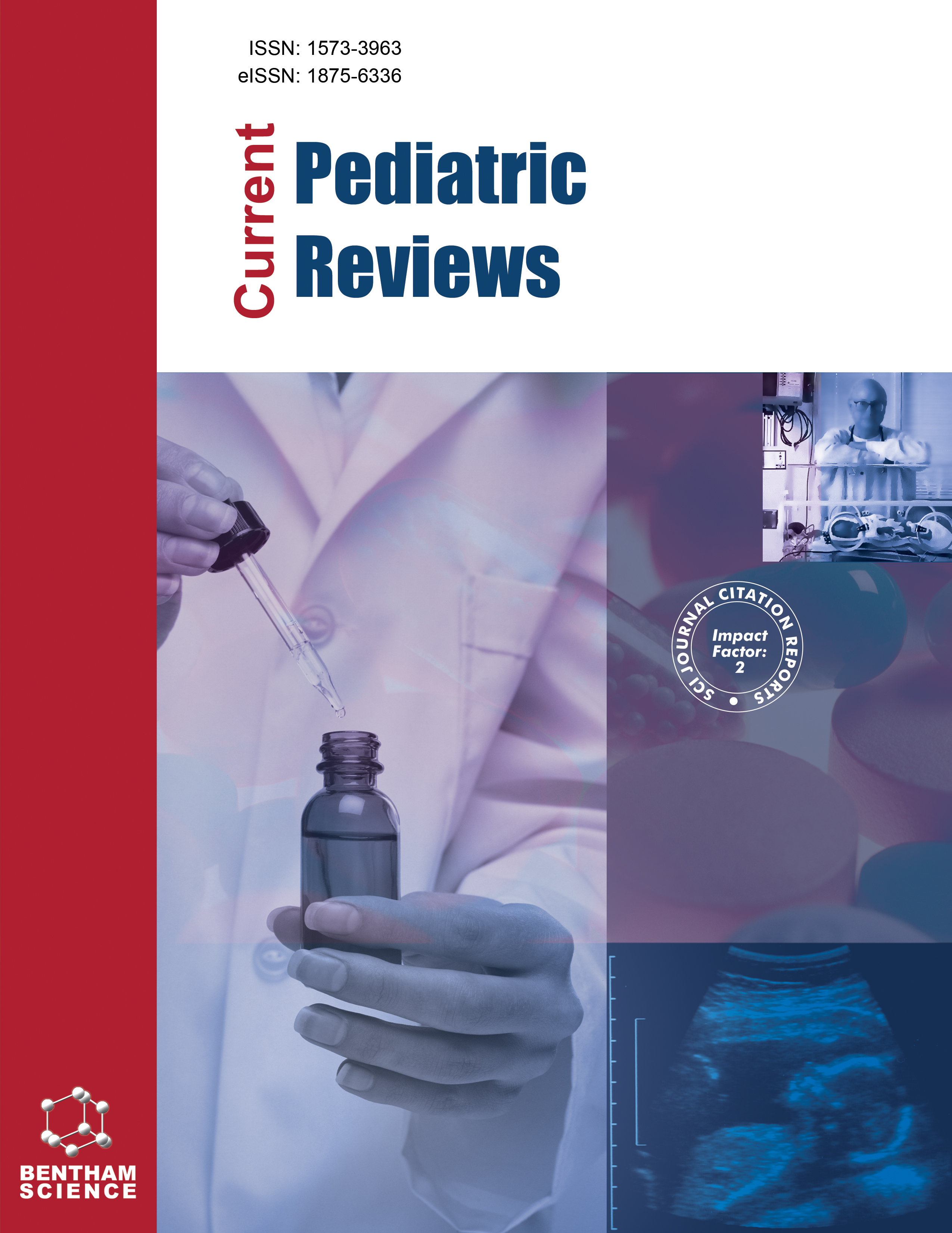- Home
- A-Z Publications
- Current Pediatric Reviews
- Previous Issues
- Volume 13, Issue 3, 2017
Current Pediatric Reviews - Volume 13, Issue 3, 2017
Volume 13, Issue 3, 2017
-
-
Refractory Causes of Kernicterus in Developed Countries: Can We Eradicate G6PD Deficiency Triggered and Low-Bilirubin Kernicterus?
More LessBackground: Glucose-6-phosphate dehydrogenase (G6PD) deficiency triggered and low-bilirubin kernicterus persist despite current prevention strategies. Objective: Review efforts to eradicate bilirubin induced brain injury in these two conditions including novel approaches to risk assessment and hyperbilirubinemia evaluation. Result and Conclusion: In the case of G6PD deficiency, a heightened awareness of populations at risk Read More
-
-
-
Conjunctival Icterus – An Important but Neglected Sign of Clinically Relevant Hyperbilirubinemia in Jaundiced Neonates
More LessAuthors: Abeer Azzuqa and Jon F. WatchkoBackground: Conjunctival icterus is a largely neglected physical sign that may be helpful in identifying neonates with clinically relevant hyperbilirubinemia by practitioners in the hospital and outpatient clinic or parents at home. Objective: A recent NICU based study reported that conjunctival icterus is often a sign of significant (TSB ≥ 17 mg/dl) hyperbilirubinemia and TSB levels ≥ 76th-95th percentile on the Bhuta Read More
-
-
-
Update on Phototherapy in Jaundiced Neonates
More LessAuthors: Finn Ebbesen, Thor W. R. Hansen and M. J. MaiselsBackground: Even relatively low serum bilirubin concentrations can cause neurodevelopmental impairment in extremely low birth weight (EBWL) infants, while sequelae from hyperbilirubinemia in late preterm and term infants are rare and occur only at very high serum bilirubin levels. Phototherapy is the current treatment of choice. Objective: To present an update on the most important issues involved in phototherapy Read More
-
-
-
Update on Predicting Severe Hyperbilirubinemia and Bilirubin Neurotoxicity Risks in Neonates
More LessAuthors: Pearl W. Chang, Thomas B. Newman and M. J. MaiselsExtreme hyperbilirubinemia and kernicterus, though rare, continue to occur despite the adoption of universal screening. Unless they are known to have glucose-6-phosphate dehydrogenase deficiency, infants who currently develop kernicterus in high resource countries are often otherwise healthy newborns discharged from the well-baby nursery. In this review, we highlight risk factors that increase the risk of a newborn ≥3 Read More
-
-
-
Mechanisms Involved in the Increased Hemolysis in the Fetus and Newborn
More LessAuthors: Bracci Rodolfo, Perrone Serafina and Buonocore GiuseppeThe suicidal death of erythrocytes should be considered a possible cause of hemolysis and plasma bilirubin overload when there is no evidence of an immune-mediated hemolytic anemia, no consumptive red blood cell disorder, no morphologic or laboratory data to suggest a problem of the red cell membrane, and no evidence of a quantitative or qualitative defect in hemoglobin synthesis. In neonatal period, xenobiotics, cyto Read More
-
-
-
The Importance of Hemolysis and Its Clinical Detection in Neonates with Hyperbilirubinemia
More LessAuthors: Ronald J Wong, Vinod K. Bhutani and David K. StevensonBackground: Hyperbilirubinemia is a benign transitional phenomenon that occurs in 60% to 80% of all term infants. The degree of hyperbilirubinemia and hence risk for developing bilirubin-induced neurologic dysfunction or BIND is dependent upon two major processes: (i) bilirubin production and its elimination. Objective: The aim of this review is to address the importance of hemolysis and its clinical detecti Read More
-
-
-
The Neurological Sequelae of Neonatal Hyperbilirubinemia: Definitions, Diagnosis and Treatment of the Kernicterus Spectrum Disorders (KSDs)
More LessAuthors: Jean-Baptiste L. Pichon, Sean M. Riordan, Jon Watchko and Steven M. ShapiroBackground: Despite its lengthy history, the study of jaundice, hyperbilirubinemia and kernicterus suffers from a lack of clarity and consistency in the key terms used to describe both the clinical and pathophysiological nature of these conditions. For example, the term Bilirubin-induced Neurological Dysfunction (BIND) has been used to refer to all neurological sequelae caused by exposure to high levels of bilirubin, to onl Read More
-
-
-
Maternal Empowerment - An Underutilized Strategy to Prevent Kernicterus?
More LessAuthors: Richard P. Wennberg, Jon F. Watchko and Steven M. ShapiroBackground: Kernicterus is a common cause of death and morbidity in many Low- Middle-income Countries (LMICs) and still occurs in affluent nations. In either case, the immediate cause is delayed treatment of severe hyperbilirubinemia. In the West, a provider driven “systems approach” has been widely adopted to identify babies at risk prior to discharge from birthing centers with follow up monitoring based on the serum Read More
-
Volumes & issues
-
Volume 21 (2025)
-
Volume 20 (2024)
-
Volume 19 (2023)
-
Volume 18 (2022)
-
Volume 17 (2021)
-
Volume 16 (2020)
-
Volume 15 (2019)
-
Volume 14 (2018)
-
Volume 13 (2017)
-
Volume 12 (2016)
-
Volume 11 (2015)
-
Volume 10 (2014)
-
Volume 9 (2013)
-
Volume 8 (2012)
-
Volume 7 (2011)
-
Volume 6 (2010)
-
Volume 5 (2009)
-
Volume 4 (2008)
-
Volume 3 (2007)
-
Volume 2 (2006)
-
Volume 1 (2005)
Most Read This Month
Article
content/journals/cpr
Journal
10
5
false
en


